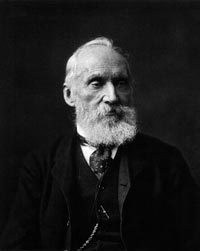
| Born: Jun 26, 1824 in Belfast, Ireland |
| Died: Dec 17, 1907 (at age 83) in Largs, Scotland |
| Nationality: British |
| Famous For: Absolute Zero, Joule–Thomson effect, Thomson effect (thermoelectric), Mirror galvanometer, Siphon recorder, Kelvin material, Kelvin water dropper, Kelvin wave, Kelvin–Helmholtz instability, and many others |
| Awards: Smith’s Prize, Royal Medal and Copley Medal |
William Thomson, 1st Baron Kelvin (or Lord Kelvin) was a British physicist who was knighted by Queen Victoria for his work as the electrical engineer who oversaw the laying of the first transatlantic cable in 1866. In 1892, he received the title of Baron Kelvin of Largs. He was the first scientist in the United Kingdom to join the House of Lords. He did much to unify the science of physics, which was just beginning to come into its own during the Victorian era.
Inventions
Lord Kelvin invented the mirror galvanometer used in cable signaling and the siphon recorder, which was used to received the signals. An avid seaman, he also invented the first ship’s compass that was free of the magnetic influence of any iron on the ship. He also invented a mechanism that predicted the tide. This was useful to predict the variations in sea level in any port. He also suggested that gas thermometers be used for accurate temperature readings, and a thermometer scale is named after him. On the Kelvin thermometer scale, absolute zero is equal to – 273 degrees Celsius. Absolute zero is where molecular movement ceases.
Early Life
Lord Kelvin was born William Thomson on June 26th, 1824 in Belfast, Northern Ireland. His father’s job as a mathematics professor in Glasgow made it possible for William and his siblings to travel and study in London, Paris, Germany and Holland. He began to attend the University of Glasgow when he was only 10, but that was because the university held elementary school level classes. As a teenager Thomson wrote essays and even published scientific papers.
Cambridge University
Thomson entered Cambridge University in 1841 where he enjoyed an active life as a student. He participated in many activities, but science was his great love. He graduated four years later. He was a Second Wrangler, which was the second highest ranked undergraduate degree in math. He was also named a fellow of his house and worked in the laboratory of the famous scientists Henri Regnault in Paris. At around this same time the University of Glasgow elevated Thomson to the chair of natural philosophy. He was only 22 years old.
Later Life
Thomson held the chair of natural philosophy at the University of Glasgow until his retirement in 1899, over a half century later. In 1893 Thomson was the head of a commission created to design the power station at Niagara Falls. Though he was at first determined to use direct current to power it, he was impressed by fellow physicist Nikola Tesla‘s embrace of alternating current.
Lord Kelvin published at least 661 papers on a variety of scientific subjects and held over 70 patents. He died on December 17, 1907 and was interred in Westminster Abbey.